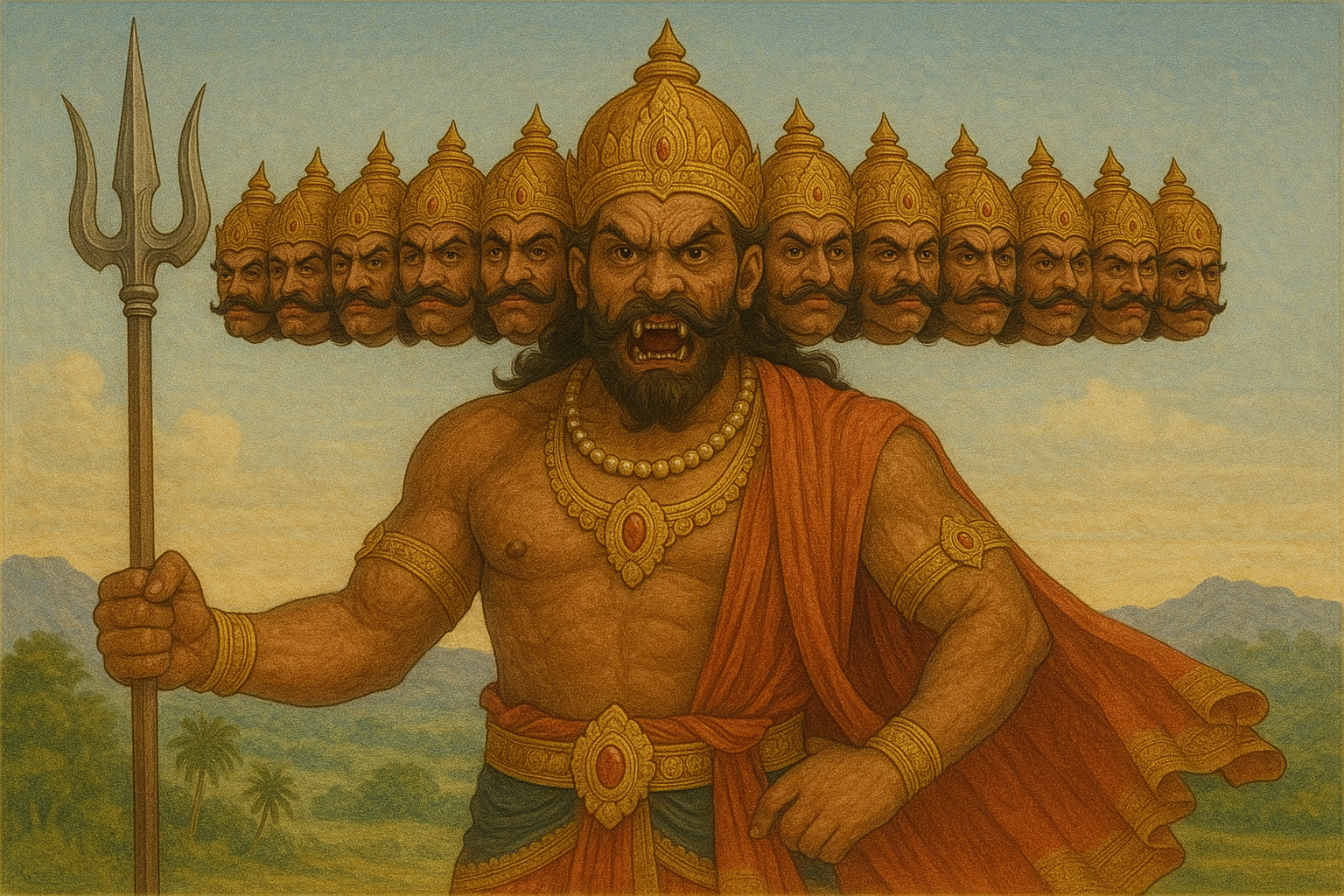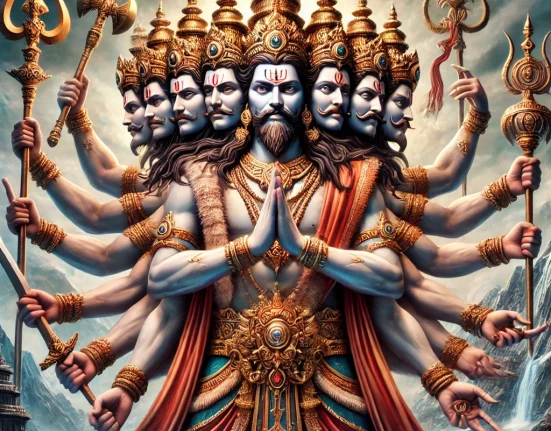The question of whether Ravana is a demon or god has sparked passionate debates for millennia among scholars, devotees, and seekers of truth. Far from being a simple tale of good versus evil, the story of Ravana reveals one of the most complex and fascinating characters in Hindu mythology—a being who embodied both divine wisdom and human flaws, scholarly brilliance and tragic downfall.
The Paradox of Ravana: Beyond Black and White
Traditional narratives often paint Ravana as the archetypal villain of the Ramayana, the ten-headed demon king who kidnapped Sita and met his doom at Rama’s hands. Yet beneath this surface lies a character of extraordinary depth and contradiction. As Lord Rama himself acknowledged when instructing Laxman to seek wisdom from the dying Ravana, he was “a man full of wisdom and is a good ruler and leader, but his choices made him bad”.
This nuanced perspective reflects a profound truth: Ravana was neither entirely demonic nor wholly divine, but rather a complex being whose greatness was overshadowed by a single, catastrophic mistake.
The Scholar King: Ravana’s Intellectual Magnificence
Master of Sacred Knowledge
Ravana’s scholarly achievements were legendary. He was a master of all four Vedas and six Shastras, making him one of the most learned beings of his time. His ten heads, rather than representing malevolence, symbolized his vast intellectual capacity—each head representing mastery over different fields of knowledge including logic, philosophy, astronomy, and medicine.
As a Brahma Jnani (one who has realized Brahman), Ravana possessed deep spiritual knowledge that few could match. His contributions to various fields remain remarkable:
Medical Pioneer
Ravana authored the Arka Prakasham, a comprehensive treatise on Siddha medicine and treatment. This ancient medical text reveals his profound understanding of pharmacology and therapeutics. He also wrote the Kumara Tantraya, focusing on gynecology and pediatric medicine at the request of his pregnant queen Mandodari. His medical expertise was so renowned that Sri Lankan folk tales even speak of him treating both Rama and Lakshmana with his own hands when they were injured in battle.
Astronomical Genius
The Ravana Samhita, his astrological masterpiece, demonstrates his command over astronomy and astrology. This text provides detailed insights into planetary positions, palm reading, and predictive techniques that continue to be studied today. Ravana was said to have such mastery over celestial forces that he could control the Navagrahas (nine planetary deities).
Musical Virtuoso
Perhaps most famously, Ravana created the Rudra Veena and composed the immortal Shiva Tandava Stotram. This powerful hymn celebrating Shiva’s cosmic dance showcases not only his poetic genius but also his profound devotion. Legend tells of how he crafted his veena using parts of his own body—his head as the gourd, his veins as strings, and his arms as the neck—demonstrating the depth of his musical devotion14.
The Devoted Shiva Bhakta: Unparalleled Spiritual Practice
Ravana’s devotion to Lord Shiva was extraordinary and unquestionable. His spiritual practices included some of the most intense austerities ever recorded in Hindu texts. When Shiva seemed unmoved by his initial penance, Ravana began severing his heads one by one, offering them as sacred offerings in the fire. Only when he was about to sacrifice his tenth and final head did Shiva appear, pleased by such unprecedented devotion, and restore all his heads.
This divine encounter resulted in Shiva granting Ravana extraordinary boons and even gifting him a Jyotirlinga—leading to the establishment of the Baidyanath Jyotirlinga at Deoghar. Ravana’s composition of the Shiva Tandava Stotram under Mount Kailash further cemented his status as one of Shiva’s greatest devotees.
The Golden Kingdom: Lanka’s Unprecedented Prosperity
Under Ravana’s rule, Lanka achieved unparalleled prosperity and advancement. The kingdom was literally golden—not just metaphorically, but adorned with gold architecture, advanced infrastructure, and magnificent palaces. Vishwakarma, the divine architect, had originally constructed this marvel, which Ravana transformed into a center of learning, culture, and economic prosperity.
Lanka’s administration under Ravana was merit-based rather than birth-based, contrasting sharply with many contemporary societies. Even the poorest inhabitants of Lanka were well-off, and the kingdom maintained advanced trade systems, technological innovations, and architectural marvels that made it an economic superpower of its time.
The Cosmic Drama: Jay and Vijay’s Divine Plan
The deeper spiritual significance of Ravana’s story emerges when we understand his true identity as Jay, one of Vishnu’s gatekeepers in Vaikuntha2324. Cursed by the Sanat Kumaras for denying them entry, Jay and Vijay were given a choice: be born seven times as Vishnu’s devotees or three times as his enemies to return to their divine service more quickly.
Choosing the faster path, they incarnated as enemies, with Jay becoming Ravana and Vijay as Kumbhakarna24. This cosmic perspective suggests that Ravana’s actions, including the abduction of Sita, were part of a divine drama orchestrated for a higher purpose—to facilitate Rama’s avatar mission and ultimately achieve liberation through Vishnu’s direct intervention.
The Question of Respect for Women
One of the most debated aspects of Ravana’s character concerns his treatment of women, particularly Sita. While some sources suggest he respected women and never forced Sita, others provide evidence of his problematic behavior toward women like Rambha and Vedavati.
Mandodari, his learned wife and one of the Panch Kanyas, consistently advised him toward righteousness and even saved Sita’s life when Ravana threatened her in anger. Her wisdom and his marriage to such a learned woman suggest a complex relationship with feminine wisdom, even if his actions were sometimes contradictory.
Modern Perspectives: Ravana’s Continuing Relevance
Sri Lankan Reverence
In contemporary Sri Lanka, Ravana is increasingly viewed not as a demon but as a great king and cultural hero. This “Ravanisation” movement among Sinhalese Buddhists sees him as a symbol of Lankan sovereignty and resistance against colonial exploitation. Archaeological sites like Sigiriya are sometimes connected to Ravana’s legacy, representing an advanced civilization that might have inspired the legends.
Scholarly Reassessment
Modern scholarship increasingly recognizes Ravana’s multifaceted nature. His contributions to medicine, astronomy, music, and governance are being studied with fresh perspectives that move beyond the traditional villain narrative. Research into texts like the Ravana Samhita and Arka Prakasham reveals sophisticated knowledge systems that challenge simplistic characterizations.
The Tragic Hero: Hubris and Downfall
Ravana’s story serves as a profound meditation on the nature of greatness and its potential corruption. Despite his immense knowledge, spiritual achievements, and administrative excellence, his ego and attachment to power led to his downfall. His ten heads, initially representing vast knowledge, came to symbolize the ten vices that consumed him: kama (lust), krodha (anger), moha (delusion), lobha (greed), mada (pride), matsarya (envy), buddhi (intellect), manas (mind), chitta (will), and ahamkara (ego).
The Bhagavad Gita teaches that spiritual downfall begins with attachment to sensory objects, leading to lust, anger, delusion, and ultimately the loss of discriminative intelligence. Ravana’s obsession with Sita exemplified this tragic progression, transforming a great soul into the instrument of his own destruction.
Lessons for Modern Leadership
Ravana’s story offers invaluable lessons for contemporary leaders. His strategic brilliance, confidence, and charismatic leadership built a vast empire and advanced civilization. Yet his refusal to heed wise counsel—particularly from Mandodari and Vibhishana—demonstrates how ego can blind even the most intelligent leaders to truth and wisdom.
His administrative skills, merit-based governance, and creation of prosperity show the positive potential of strong leadership, while his downfall illustrates the dangers of unchecked power and pride.
The Verdict: Neither Demon Nor God, But Profoundly Human
The question “Is Ravana a demon or god?” ultimately reveals its own limitation. Ravana transcends such binary classifications, representing instead the complex nature of existence itself. He was simultaneously:
- A great Shiva devotee whose spiritual practices were unmatched
- A brilliant scholar whose contributions enriched human knowledge
- An effective ruler who created unprecedented prosperity
- A tragic figure whose ego led to his downfall
- A cosmic player in the divine drama of Rama’s avatar
Hindu philosophy teaches that everyone originates from the Divine and is essentially pure in nature. Ravana’s story embodies this truth—showing how even the most accomplished souls can become entangled in the dualities of existence, yet ultimately find redemption through divine grace.
The Eternal Teaching
Ravana’s legacy reminds us that greatness lies not in the absence of flaws but in the integration of knowledge with wisdom, power with humility, and achievement with surrender to the Divine. His story challenges us to look beyond simple narratives of good and evil, recognizing the complex interplay of light and shadow within every soul.
As Lord Rama demonstrated by honoring Ravana even in death, true greatness recognizes the divine spark in all beings—even in those who have temporarily forgotten their own luminous nature. In this recognition lies perhaps the deepest teaching of Ravana’s extraordinary life: that redemption is always possible, and that every soul, regardless of how far it may have strayed, ultimately belongs to the Divine.
The question is not whether Ravana was demon or god, but whether we can learn from his magnificent rise and tragic fall to navigate our own journey toward truth, wisdom, and ultimate liberation. In this learning lies the true gift of his immortal story—a mirror reflecting both our highest potential and our deepest challenges on the path to self-realization.



Leave feedback about this